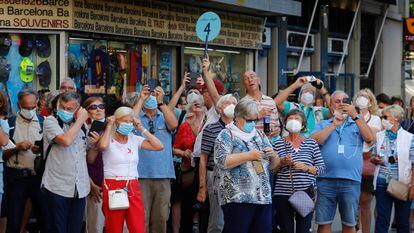Coronavirus cases rise slightly in Spain as experts warn: ‘The virus can always surprise us’
The number of hospital admissions continues to fall, but epidemiologists are calling for caution as the country heads into winter
/cloudfront-eu-central-1.images.arcpublishing.com/prisa/JNNYBN6ADNA4PN5HH7EGBUC2JI.JPG)

Since the number of coronavirus cases in Spain began to fall at the end of July, epidemiologists have been waiting for them to rise again. No one believed that the drop in contagions would continue until the coronavirus was eradicated completely, an outcome that has been ruled out for the near future. But experts expected that a moment would arrive when the number of new infections would stabilize or even rise again. And that is what has just happened.
On Thursday, the 14-day cumulative number of cases per 100,000 inhabitants came in at 43.2. This is a rise of 2.7 since last Thursday, when the incidence rate was 40.5 – the lowest figure recorded in Spain since the end of the fifth wave. Over the last seven days, the epidemiological curve has seen slight rises and falls, but it is clear that the downward trend has stalled for the moment.
But experts say this is not necessarily a cause for concern. Spain remains at a low-risk level (an incidence rate below 50 cases per 100,000 inhabitants) and is seeing what was to be expected, says Ana María García, a professor of public health at Valencia University. “Evidently the virus is continuing to circulate and now, [that the country is] practically without [coronavirus] restrictions, it is normal for it to increase a little. But it is a small rise that does not have repercussions in terms of the seriousness of cases,” she explains.
The incidence rate rose slightly on Thursday, with respect to last week, among all age groups over 20 years of age. The under-12s, the only demographic for which there is no available Covid-19 vaccine, has the highest transmission rate (54), but the data point did not rise. This seems to confirm what was seen during the last school term in Spain: the virus does not spread from the classroom to the home, but rather transmission in the community is reflected in schools.
Predictions about the pandemic have often been wrong and experts prefer to be cautious when considering the future. Nobody knows how contagion rates will change. And beyond international comparisons, which have always been problematic due to the particularities of each territory, there are few reference points to look to. Spain today is one of the countries in the world with the lowest incidence rates of the coronavirus and highest vaccination coverage – 80% of the population has been fully vaccinated.

The United Kingdom, for example, has extremely high transmission rates (753 cases per 100,000, according to the latest data from health authorities), while only 66.5% of the population is completely immunized, according to the Oxford University website Our World in Data. In Denmark, the epidemiological curve had been mirroring that of Spain’s until a month ago, and began to rise two weeks ago. In Portugal, where 86.4% of the population is fully vaccinated, contagions have also risen slightly in recent days.
But a sudden sharp rise and a new wave similar to the previous ones in Spain no longer appears to be a possibility. “[Cases] could continue to rise, but we are not expecting it to be a fast rise nor that it will have repercussions on the healthcare system,” explains García. “Now we are worried about two things: people who are not vaccinated [10% of the over-12 population] and protection from the doses falling, something we are not seeing.”
Meanwhile, the situation in Spain’s hospitals is improving. On Thursday, there were 1,775 Covid-19 patients in hospital, 434 of whom were in intensive care units (ICUs). They are figures that have been falling practically nonstop since the beginning of August, when there were more than 10,000 Covid-19 patients in wards and more than 2,000 in ICUs. This data point takes three weeks to be consolidated, but the downward trend has been evident since the end of August. On Thursday, the Spanish Health Ministry added 20 Covid-19 deaths to the official toll.
Fernando Rodríguez Artalejo, a professor of public health at Madrid’s Autonomous University, explains that certain precautions must be taken as Spain heads into winter. “Covid will mix with the flu and other respiratory viruses and we will have to see what happens. If we were in May with these figures I would be speaking with complete calm. But as it is October it is good to maintain the principle of precaution and measures such as face masks indoors,” he says.
With the virus present and still spreading in many countries, the potential for it to mutate remains thereJosé María Martín Moreno, doctor in Epidemiology and Public Health at Harvard University
The use of face masks in indoor spaces is practically the only coronavirus restriction that remains in place outside of schools, which is why experts believe it is normal for there to be a small rise in cases. José Jiménez, a researcher of emerging viruses at King’s College in London, argues that although there is data that indicates that the Covid-19 vaccines used in Spain (Pfizer-BioNTech, Moderna, Janssen and Oxford-AstraZeneca) limit the spread of the virus, the vaccines do not stop a person from contracting the virus. “As such, if measures are relaxed it is normal for cases to rise. What’s most important is that we have to take into account that the main goal of these vaccines is to prevent serious forms of the illness and deaths,” he says. “In Spain, where a large part of the population is completely vaccinated, I think it is more important to center our attention on the number of hospital admissions and deaths, and not so much on the cumulative incidence.”
All the experts who spoke to EL PAÍS, including Jiménez, agree that the virus is not going to disappear: it is going to continue to spread. “The good news is that the vaccines have completely changed the situation with respect to previous waves. This means – and it follows what we are currently seeing – that even if the virus continues to spread, the likelihood of becoming seriously ill and dying from Covid-19 is much lower. This does not mean that we have to completely forget about the virus. If there is something we have learned during this pandemic it is that the virus can always surprise us,” says Jiménez.
José María Martín Moreno, a doctor in epidemiology and public health at Harvard University, agrees: “We are at levels that are identified with a low risk of transmission, and consequently of pressure on hospitals. But, although this situation leads to optimistic expectations, we must insist that the risk is not zero or nonexistent. With the virus present and still spreading in many countries, the potential for it to mutate remains there. And if it mutates in an undesirable way, new, more contagious and threatening variants could appear that can resist the defenses of the vaccines that we have used.”
To illustrate the point, Martín Moreno points out what happened last year at the end of the home lockdown when it was said that Spain had defeated the pandemic. According to the expert, such “intensely optimistic” announcements led to “premature” lifting of restrictions. This was also seen in England, he says, when Prime Minister Boris Johnson lifted nearly all its Covid-19 restrictions on the so-called “Freedom Day.” “This has led today to an incidence rate that is 20 times higher than what Spain has, with a stalled vaccination drive and in a situation where there is enormous pressure on hospitals and the population is confused,” says Martín Moreno.
Spain has entered a low-risk situation, but there is another milestone still pending: an incidence rate of 25 cases per 100,000 inhabitants, which symbolically marks the so-called “new normality,” under the Health Ministry’s alert system. Of Spain’s 17 regions, which are in charge of their own healthcare systems, Covid-19 vaccination drive and coronavirus restrictions, only Galicia and Asturias have reached this threshold. Artalejo thinks it is “technically possible” to meet this goal, but says it will be “very complicated” to do so while the under-12s are not vaccinated. The pharmaceutical company Pfizer has prepared a Covid-19 vaccine for the five-to-12 age group that is waiting to be approved by the European Medicines Agency (EMA). If it gets the green light, Spain’s expert vaccination team, which advises authorities and updates the country’s immunization strategy according to the latest scientific evidence, will have to decide whether to approve its use.
/cloudfront-eu-central-1.images.arcpublishing.com/prisa/6573A322X5DZJP3G2Z46WB6YG4.jpg)
/cloudfront-eu-central-1.images.arcpublishing.com/prisa/IA3NO42IDBALXENPPSA3LHOWPA.jpg)










































